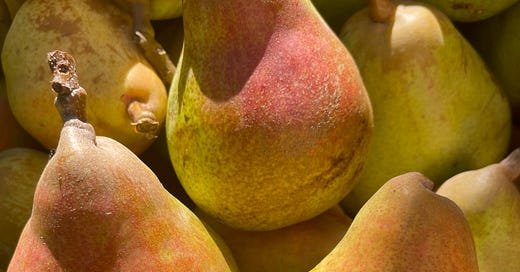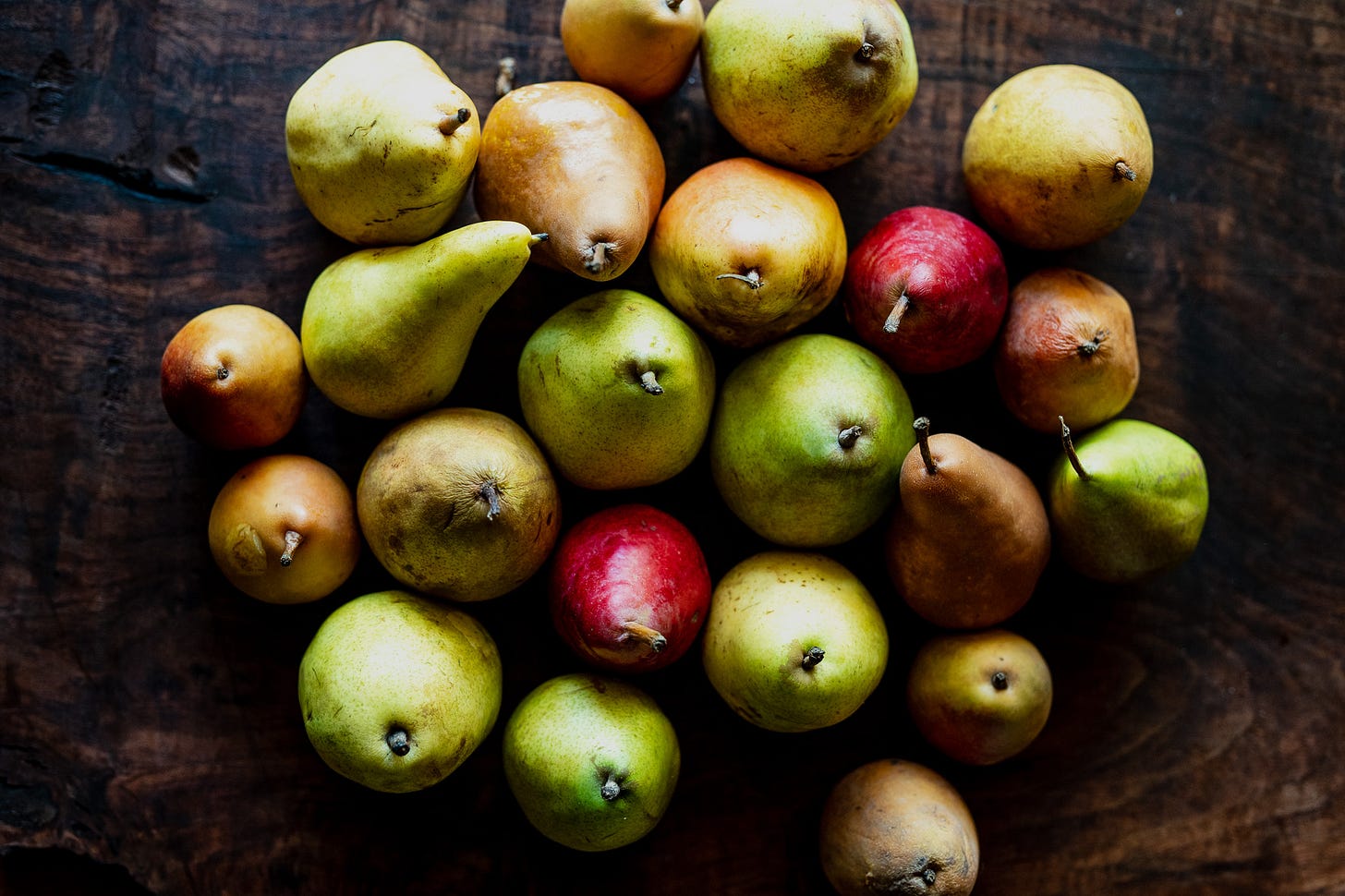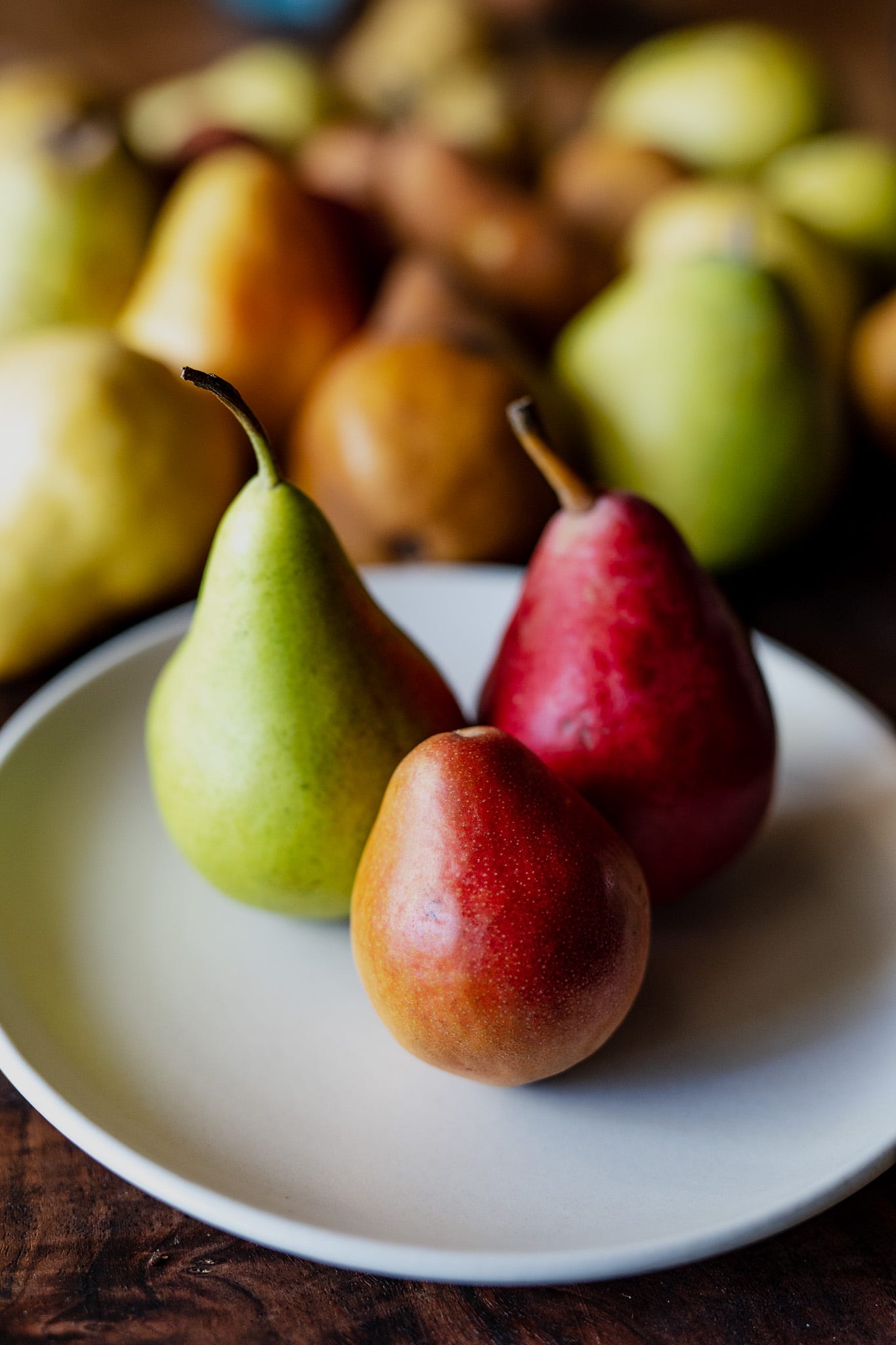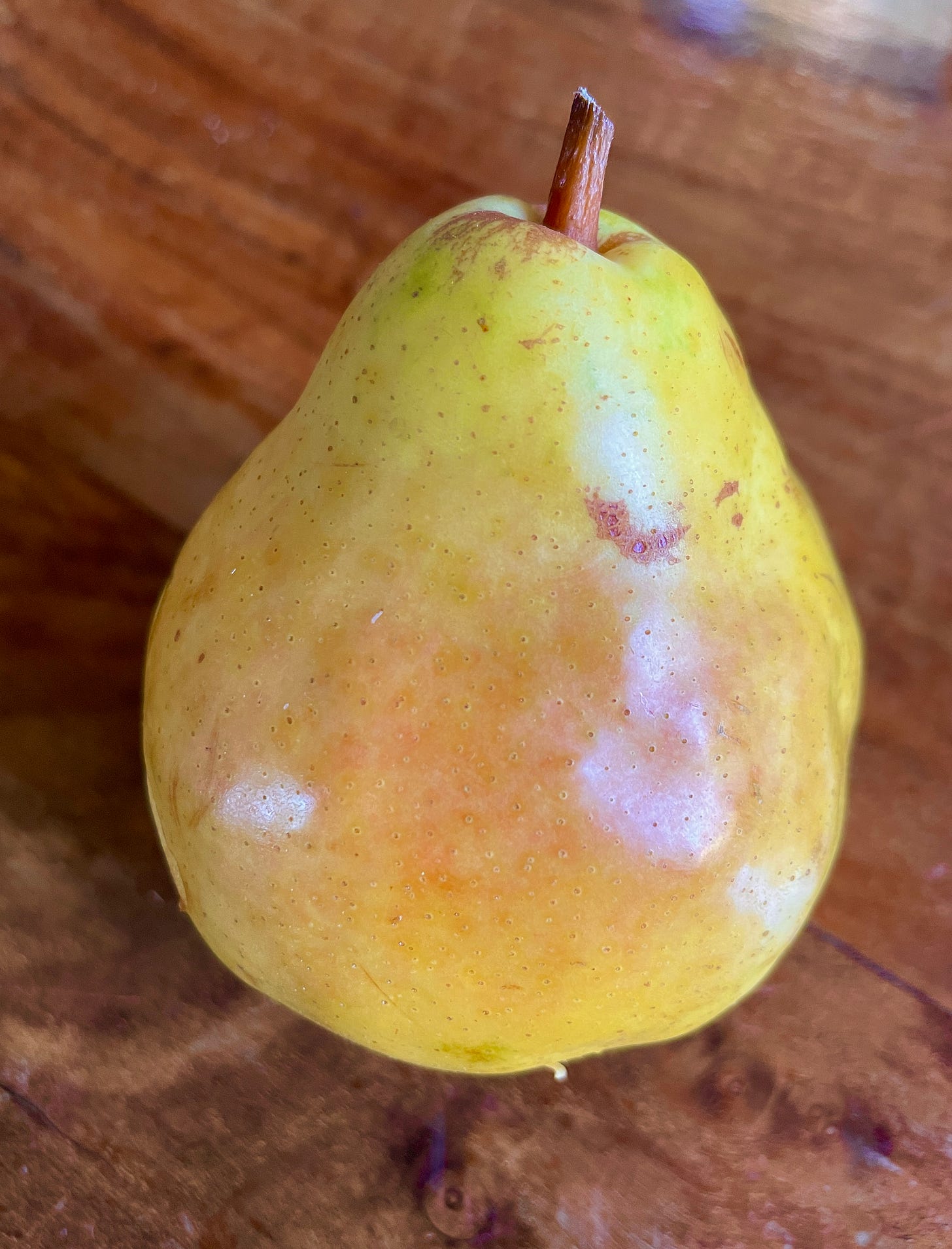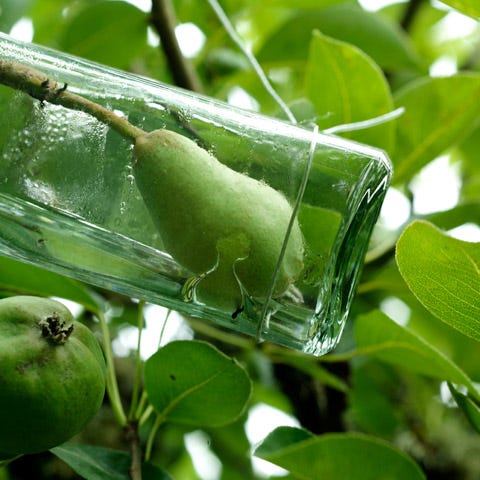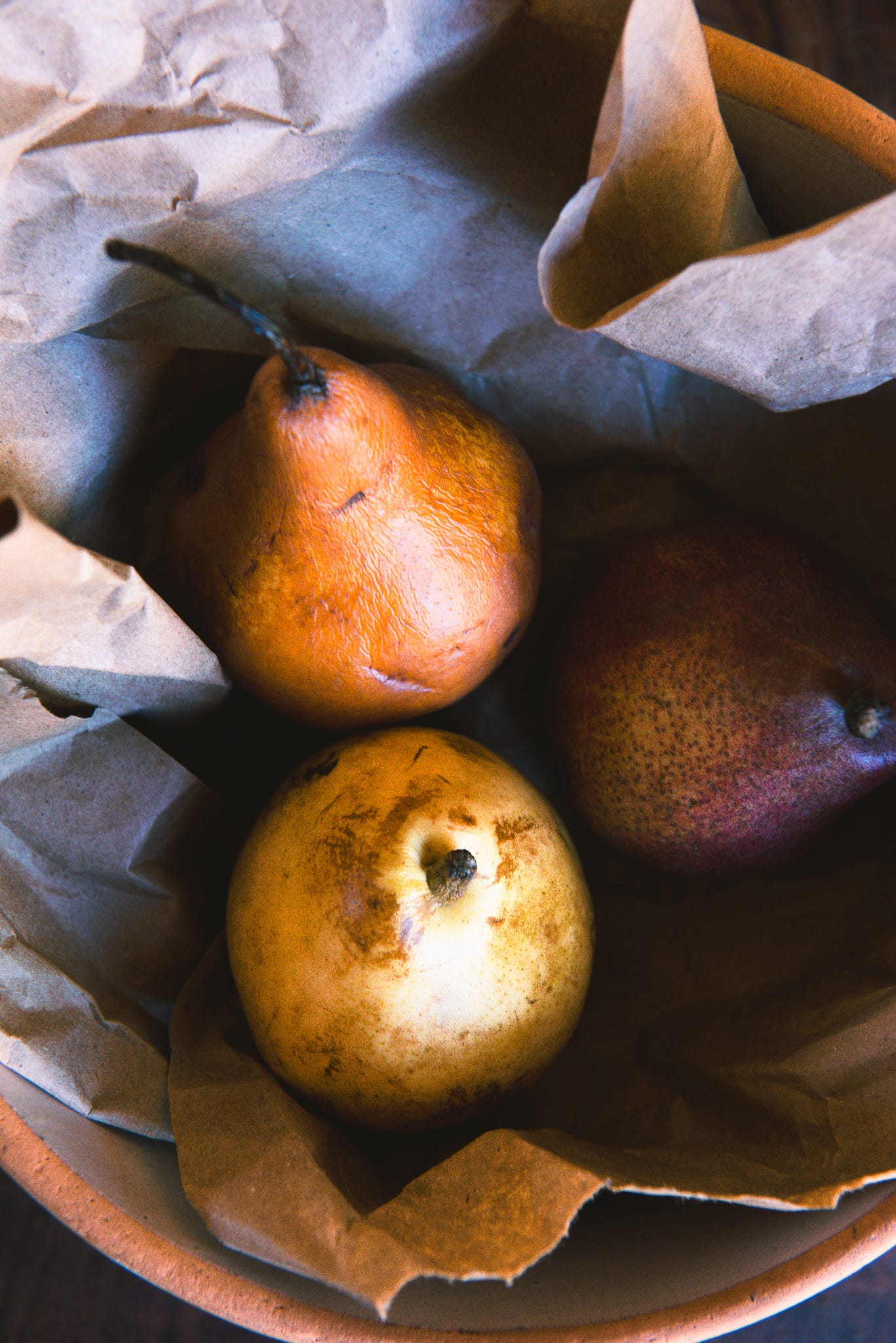For weeks now, I have watched various kinds of pears ripen on my kitchen table. Although the apples that sit among them inspire a kind of admiration, I find myself, instead, with warm feelings toward pears. Pears appeal to the heart, yet, I don’t pity them.
“Cold in the dish
Growing late
The Pear is a fruit
Burnt offering
To life, like
A breast exhausted
Among bananas
Extraneous
And apples, candid
Ruddy, content
The poor pear:
Who brings it to be?"
—"The Pear" Vinicius de Moraes
Pears are more beautiful than handsome and enjoy a feminine association, perhaps even a mystique, part of which is explainable. In contrast with the apple, pears are tenderer in the flesh and more fragile; where the flavor of the apple is robust, the pear is subtle. Bite into an apple, and you meet resistance. A ripe pear is soft and yielding. Add to this the exceptionally smooth skin of many varieties, the fairness and occasional blush of its cheek, and the graceful curve of its form. While it is common to find the old varieties of European pears named after their horticulturist fathers, the more fanciful names they are given are more often feminine:
Belle, Doyenne, Duchesse, and Comtesse; there are numerous Madames but only a few mademoiselles; alongside these, there are the many dedications to women, the Katy, the Sabine, the Maria, the Louise d'Orleans; the invocations to female martyrs and saints—Jeanne d'Arc, Sainte Anne, Therese, Dorothee. Standing alone is the anonymous Fertility.
Pears demand patience and careful attention at each growth stage, from sapling to tree to ripened fruit. The pear is unpredictable and unforgiving of neglect. Pears shed no tear, like the fig, to signal their peak. Pears give themselves when they are ready and are, more often than not, surprising. In the words of the English gastronome Edward Bunyard, "The pear must be approached, as its feminine nature indicates, with discretion and reverence; it withholds its secrets from the merely hungry." (Edward Bunyard's Anatomy of Dessert).
The pear is one of the most ephemeral fruits; once it has reached its culmination, it makes fast toward decay. Unlike other fruits, it prefers to exhibit no shame and rots from the inside out. Neither is the virtue of the pear's subtlety without its cost. The full flavor of the pear must be reached for and as with all subtle things, imperfections are more noticeable. Pears can be profoundly disappointing. When captured at the elusive moment, however, a ripe pear is nothing less than a consummation.
Most people enjoy ripe pears, which are pears whose flesh has mellowed to the core and whose color, perfume, and sugar are fully developed. While it is possible to enjoy some varieties directly from the tree, most pears are picked green. Pears continue to ripen off the tree. This is quite an advantage to the grower who needn't worry about pests attracted by the perfume and increased vulnerability of softening fruit or changes in weather and temperature; it also permits them to be moved into an optimal environment for ripening. The pear also stops producing grit cells, the textural feature present in all pears to one degree or another, when it is removed from its source of vitality; this is why pears that are allowed to ripen fully on the tree are more likely to be mealy. Nevertheless, ripening pears at home can be frustrating. Patient waiting, sometimes for weeks, often produces no observable change, and it is also common to return, after what seems like a matter of hours, to a musky mess. That pears are inscrutable, mercurial, and uncooperative is perhaps not an altogether fair assessment.
There are three acknowledged stages in the progress of the pear once it has fully formed on the tree -- maturation, ripening, and senescence. Maturation is the process by which fruit acquires the ability to ripen properly. Like a mother in labor, the pear begins to breathe heavily at this stage; a rise in the respiratory rate called the climacteric is accompanied by a dramatic increase within the fruit of ethylene, the compound that induces ripening. Pears must arrive at maturity before they will successfully ripen. Ripening is the process during which the mature fruit becomes fully edible and includes several important events: enzyme synthesis, flesh softening, development of perfume, conversion of starch to sugar, change in "ground color" from green to yellow, or deepening of the red pigment in some varieties. Ripening proceeds at different rates among different varieties of pears. Senescence follows ripening and is marked by the deterioration of the fruit and the cessation of its functions. Like all living things, the fruit is "mortal", although the seed survives.
It is likely, then, that the discouraging fruits that sat implacably in the dish were not picked mature (a grower cannot test every pear in the orchard) and that no amount of waiting will make a difference. The perfect pear depends on knowledge of the behavior and peculiar indications of certain varieties. One can't expect the Winter Nelis to ripen like the Bartlett, nor does the same criteria that are used to judge the progress of one apply to the other. Bartletts ripen much faster, develop a noticeable, rich perfume, soften dramatically, and lighten in color. Such transformations in the Winter Nellis are muted and occur more slowly.
Recommendations regarding the storing and ripening fruit have not changed much since antiquity. Varro's On Agriculture describes the ideal "fruit house," which might well have been the model for the cellars and larders of the days before refrigeration. Evidently, these rooms, with their cool drafts and marble ceilings, walls, and floors, were also thought of as a great place to set a table. He suggests… "If luxury allows people to do this in a picture gallery, where the scene is set by art, why should they not enjoy a scene set by nature, in a charming arrangement of fruit?" (Varro, Pg. 295 Loeb/ Bk I, LIX.)
An early 20th-century recommendation for the storing and ripening of pears reads as follows: "A cool cellar is excellent, and then when they first show signs of ripening, bring [ into a warm room for a few days, and as a last refinement, return them to the cellar a few hours before using to gain the slight chill which enhances their welcome as a dessert." (E. Bunyard. The Epicure's Companion pg. 218-19)It is impossible to determine what is meant by "cool" in both of these accounts. Varro's Rome and Bunyard's London would likely have measured this term differently.
It is generally acknowledged today that the optimum conditions for storing pears are a "room temperature" of about 65 degrees F. and a relative humidity of 80 to 85% which would rule out most home environments and the refrigerator as an option. Pears should be set out in layers in a dark or shaded place. At higher temperatures or in sunny places and in cold storage, pears last much less well than apples.
Despite its contrary aspects, the pear is kin to the apple. Along with it, the quince, and medlar, it is a pome-fruit. Pome derives from the Latin pomum that initially meant fruit, or fruit tree, which makes this appellation something of a redundancy. Later, however, we learn that pomum refers to the apple. The Latin word malum undergoes a similar specification, describing originally most soft-skinned tree fruit and later simply the apple. Incidentally, although there is no mention of the pear in the Bible, neither is the infamous apple present in the Garden of Eden as we have been taught to expect. According to the scholar John Anson, the Latin words for apple (malum) and evil (malus) were conflated to form the mistaken impression that the apple was the forbidden fruit. Doesn't it seem likely that Adam would have been more tempted by a pear? I am not the only one to think so.
"Some say
It was a pear
Eve ate.
Why else the shape
Of the womb,
Or of the cello,
Whose single song is grief
for the parent tree?
Why else the fruit itself
tawny and sweet
which your lover
over breakfast
lets go your pear-
shaped breast
to reach for?"
(Linda Pastan in Voices within the Ark, an international anthology edited by Howard Scwartz and Anthony Rudolf, Avon 1980. p. 578)
Pome fruits are distinguished botanically in that their reproductive parts are encased in fleshy tissue, interpreted by one school of anatomists as a kind of swollen receptacle. It is this receptacle (the enlarged calyx), not strictly the fruit, the mature or ripened ovaries, and any closely associated parts that we find so delicious in ripe pears.
The pear least of all resembles its ball- or globe-shaped cousins (the classic shape of a pear is "pyriform"). Although it shares the same large, nearly cosmopolitan family (Rosaceae), whose members include among 100 other diverse genera, roses, and other edible fruits such as berries, almonds, peaches, cherries, and plums, its ancestry is not direct. Since apples and pears do not belong to the same genus they do not successfully hybridize. Nor do they seem even to be hospitable to one another; buds of pear are not easily grafted on the apple, although they unite readily with the quince and hawthorn, both of which belong to distinct genera.
Perhaps more than any other fruit of the orchard, the pear is an individual and differs in shape and size, flavor, and texture. Finicky about its surroundings, harder to grow, less tolerant of extremes of heat or cold, demanding suitable company—most all pears are self-sterile, and to assure a crop, mutually interfertile varieties must be planted near each other—it is resistant to efforts to reduce it to uniformity. Botanists number 20 to 25 species of pears, which are found in the Northern Hemisphere of the Old World. There is no known pear native to the Southern Hemisphere or to the New World. Ten or twelve pears are found in China, three or four of which are also natives of Japan. One has been found in Korea, and another in the Western Himalayas. Other habitats for wild pears range over an extended area westward from Turkey through Persia and Asia Minor into southern and western Europe and northern Africa.
Three wild species of Old World pears are now familiar to us: The pear most commonly cultivated in ancient and modern orchards today is Pyrus communis, a native of southern Europe and Asia as far as Kashmir. The species comprises between 2000 and 3000 orchard varieties. From Pyrus Serotina come the "sand pears" of China and Japan, so called for the abundance of grit cells in their flesh. In America, the more spherical Asian pears, with their rough, russet skins and long stems, are often mistaken for apples; what's more, they are occasionally misnamed "pear-apples" perhaps to allure the consumer with the promise of an attractive-sounding hybrid which in any case it couldn't be.
It can never be known precisely when pear domestication first began or from what wild pear the cultivated pear came. Historians have had to content themselves with what the pear was when written records began, although the mention of pear cultivation and orchard operations, such as planting, grafting, and pruning, proves that the pear's domestication antedates the writing of books. The earliest records of pear cultivation begin in Ancient Greece. Pears figure among the "gifts of the gods" in the seventh book of Homer's Odyssey (The Odyssey, VII.115 translated by Richard Lattimore, pg. 114), proving that pears were under cultivation nearly a thousand years before the Christian era. Yet, there is no indication in Homer that husbandry had been developed or whether varieties of pears had been identified or distinguished. The writings of another later Greek, Theophrastus (370-ca.286 B.C.), "Father of Botany" to the botanists, confirm that almost all of the means and methods used today to assist nature in the growing of pears were known in his time. In his Enquiry into Plants, Theophrastus knew the difference between the products of pears propagated from seeds, roots, and cuttings; he described grafting, distinguished between wild and cultivated pears, compared various soils and growing locations, and enumerated general diseases and the effects of sun, wind, and season.
The pear, as might be expected, was also cultivated in Italy. The Roman statesman Cato (B.C. 234-149), who wrote the first Latin treatise on farming, fruit growing, and gardening, lists 5 varieties of pears by name, as well as methods of propagating, grafting, caring for fruits, and preserving them. In his Natural History, Pliny A.D. 23 -79), the great compiler adds nearly 40 new sorts, names them, and describes the attributes of some. Pliny believed that all raw pears were indigestible, and he advised boiling them in water and honey before eating. It might be inferred that pears were eaten green in the Italy of his day; as such, they would very likely have been hard to stomach. He also makes evident that the Romans used pears for medicinal purposes. Poultices and decoctions were made from pears to "disperse flesh lesions" and "indurations"; boiled ashes of pear wood were believed to be an effective antidote to mushroom poisoning. Wild pears, sliced and hung in the air to dry, arrested "looseness of the bowels." It also becomes clear from Pliny's descriptions of pear types that the twenty outstanding characters (smooth or russet skin; red, yellow, or green color; large or small size; early or late season; long or short stem; round, oblate, ovate, and pyriform shapes; granular, buttery, or breaking flesh, sweet or acid flavor which differentiates the varieties of pears now cultivated, were recognizable in the pears of this much earlier period.
As sophisticated as the early treatises were for their time, they were not without certain superstitions. On the matter of grafting, Pliny mentions that "religious scruples" prevented the crossing of all varieties of plants by grafting. One of the most preposterous and persistent myths, even in the 18th century in England, is the belief that driving an oak or beechwood plug through a hole born in the trunk will cause the tree to render better pears. The recommendation included the advice that if the wound did not heal, it should be washed with wine lees for fourteen days which would, in any event, improve the flavor of the fruit. Such a recommendation is reminiscent of Theophrastus' report of the practice of "punishing" trees -- root pruning, gashing stems, and driving iron pegs into the trunk. The last method was thought an effective disciplinary measure to "chasten" a tree lusher in leaves than fruit. (Enquiry Into Plants, II, vii.6 Loeb, pg 151)
In the 1500-year period following Pliny, few new facts regarding the evolution of the pear came to light. With the fall of the Roman Empire in the 5th century, pomology was all but lost as agriculture became more preoccupied with producing the necessities of life. The birth of printing in the middle of the 15th century provided a stimulus, however. One particularly influential work was that of Pietro de Crescenzi, whose influential book on agriculture, written in 1230, was later printed in numerous editions and in several languages and had a large effect on the horticulture of Europe for the next three or four centuries.
The work of another Italian, Agostino Gallo, regarded as "the restorer of agriculture in Italy after the dark ages," furnishes a list of the prominent pears of the mid-sixteenth century. There is speculation about how the pear entered France, where many new varieties were developed in the 16th and 17th centuries. Charlemagne, in the ninth century, is reported to have commanded his orchardists to plant varieties for the distinct purposes of eating raw, cooking, and utilizing late into the winter, providing evidence of the likelihood of many species under cultivation. Though the pear enters another five-century period of silence in France, it is assumed that pears were cultivated, if not by others, at least by monks. When the pear resurfaced in the 16th century, it was evident that monasteries not only occupied themselves with the culture of the pears but also increased the number of new varieties.
In the 16th and 17th centuries, France became the leader in publishing agricultural literature. This marked a new era for the pear and for agriculture in general as the new thinking based on first-hand observation and study, aided by the printing press, caused a departure from the Greek and Roman traditions. Although there are several important figures that stand out, there is one, Le Lectier, attorney of the King at Orleans, whose passion for the pear and zealous pursuit to improve and distribute varieties infected the country. The desire to imitate him was so great that many people began planting and exchanging pears at Le Lectier's bequest. Le Lectier is said to have introduced the golden age of pomology as there had been no other period in history in which so many well-to-do people occupied themselves with the cultivation of the pear. Yet, it is the Belgian pear growers who are credited with producing the modern pear. Aided by ideal soils and climate, the Belgian growers furthered the development of the pear and refined its qualities by cultivating only the most proven varieties. Newfound knowledge of the sex of plants and subsequent experiments in hybridizing amounted to a revolution for the pear; the appearance of new pear varieties up until this time depended upon the chance products of promiscuous seedlings in orchards, gardens, and forests. Following the lead of the passionate horticulturist Nicolas Hardenpont, numerous amateurs, among them, lawyers, physicians, apothecaries, men of the cloth, and the leisure class introduced hundreds of new varieties and brought about a complete and rapid transformation of the pear. It is largely due to the work of the Belgians that pears with a soft, melting texture, the so-called beurres (butter pears), predominate to this day. Before the Belgians improved them, nearly all pears were crisp or breaking in flesh.
Various pears came to the New World almost entirely from Belgium and France. Although England provided many other fruits and garden crops to America, we are scarcely indebted to her for the pear. England takes credit, however, for America's most popular and widely grown pear, the Bartlett, known in England as William's pear after the nurseryman who distributed it there. It was first discovered in the late 18th century as a wilding in England by a schoolmaster named Stair, yet its history pre-dates its appearance in England. It was identified much earlier in Italy where it was called the Bon Cristiano. Waverly Root complains that it was the French who confused its nomenclature, "alleging that St. Francis of Paola brought it from Italy as a present to Louis XI”. He concludes that this story must be of doubtful authority since Louis XI reigned in the 15th century and "the Williams certainly goes no farther back than the eighteenth." (Food, Waverly Root pg 335). Root overlooks at least one earlier mention, however, that of Agostino Gallo, who lists the Bon Cristiano among nine other pear varieties. This pear must have been as common in the mid-16th century as Gallo reports that almost everyone had one in his garden. Gallo sheds no light, nevertheless, on the reason for the epithet. Under the name William’s'Bon Chretien, the pear was imported to America in 1797 or 1799 and planted in the estate of Thomas Brewer at Roxbury, Massachusetts. This land was later purchased by one Enoch Bartlett, who apparently did not know the original name of the pear and allowed it to be distributed under his name, which, to this day, it has retained.
England produced another curious landmark in the history of the pear, the so-called "Warden: after the Cistercian abbey in a town by that name. This firm and crisp-fleshed pear was a long time favorite for pie and pastry making. Wardens were often considered to be distinct fruits in English herbals and early fruit books and Shakespeare's clown in A Winter's Tale says, "I must have saffron to colour the warden pies". (Oxford English Dictionary)
Although the English followed the Belgians and the French in cultivating the pear, they did not attempt to improve what was called the "Choke pear", a name applied to any wild or astringent type of pear. In France, the wild pear was called poire d'angoisee (pear of anguish) because of its harshness and inedibility. The expression "avaler des poires d'angoisse" means to eat umble pie. (Dumas on Food, trans. Alan and Jane Davidson, Oxford U.P., pg. 213). Despite its unwelcome flavor, the choke pear was very juicy and, as such, suitable for the making of perry, a fermented beverage; after a few months in the vat, it was found to become as mild and pleasant as wine.
Pear brandy produced today by a more sophisticated process in France, Switzerland, and relatively recently in America, goes by the name of Eau-de-Vie de Poire or Pear William. The former is a distillate of pear wine, the latter an infusion accomplished neatly in the bottle itself. When the pear (generally a Bartlett) is the size of a grape, a bottle is placed over it while still on the branch. When the pear matures, the branch is cut away, and the fruit and bottle are washed and filled with clear brandy.
Pears came to America with the earliest French and English settlements. Records in the proceedings of the American Pomological Society contain detailed descriptions of extraordinary trees of great girth, height, and age, which served as monuments to mark the introduction of the pear to this country. From these records it is clear that early in the history of New England, and particularly Massachusetts, the pear was a prominent fruit. New varieties and most all of the introductions from abroad originated in that state. Until the mid-1850s, the pear industry in America was also centered there. Noble Pear trees of enormous size survived until the final years of the last century on the sites of old French settlements in Canada, the Great Lakes region, and the Midwest. According to the horticulturist U.P. Hedrick who records his visit to the old trees in 1899:
"The trees have the majestic port of a century-old elm or oak. They attain a height of eighty feet; a girth of eight or ten feet is not uncommon, while one monarch measured by [this] writer fell a few inches short of eleven feet in circumference three feet from the ground. The leaves are small but abundant and are of the luxuriant green color that betokens great vigor… No one knows the age of most of these ancient lichen-covered giants, although one which stood until a few years ago was known to have been planted within the pickets of the palisaded fortress of Detroit in 1705." (The Pears of New York, U.P. Hendricks pg. 48.)
Although the pear began its history along the Atlantic seaboard, the center of pear cultivation and industry eventually shifted to the more equable climates of the Pacific states. Time has proven that most parts of America are uncongenial to the pear, which cannot withstand sudden extremes or prolonged periods of heat and cold, dryness, or wetness.
Franciscan monks were the first to establish pear plantings in their mission gardens in California. Later, pioneers renovated some of these orchards through grafting, land cultivation, irrigation, and pruning. Their improvements, along with the visible example of the health and vigor of these old trees, stimulated plantings by the gold seekers of 1849. Meanwhile, the orcharding of pears and other hardy fruits marked the beginning of pear culture in Oregon and a new ear for improved varieties of pears along the coast from British Colombia to Southern California. Most of the expansion in pear growing since 1920 has been in the three states of California, Washington, and Oregon. Although second today behind France in total production, this region is the most highly commercialized in the world and produces about 85 percent of the United States pear supply. Unfortunately, with the advent of commercialization and the demand to produce predictable and consistent yields, the pear's rich legacy exists only as a matter of folklore. The U.S. Department of Agriculture proclaimed December National Pear Month in 2004.
Cooks have much to learn about their craft, from pears about restraint and the rewards of patience. Fruit “intends” nothing as it relates to human consumption. Its ripening is fundamentally a biological imperative rather than a wish to please human taste. Yet all food offers the promise of an answer to human needs and desires, from basic sustenance to aesthetic and sensory pleasure. To neglect pears on the table and then return to find them ripe days later is merely a lucky coincidence. But to keep them in mind as they ripen is to practice the art of cooking in its simplest form.
If you find yourself connecting with the work here, consider upgrading to paid. With a yearly subscription, you’ll have access to the full archive of all posts, the ability to join the thoughtful conversations in the comments section, and the knowledge that you support independent journalism.

